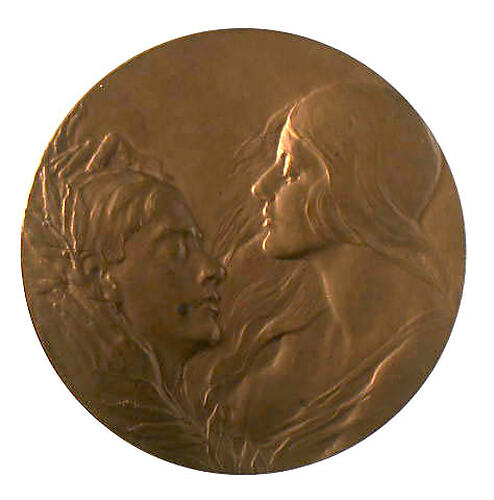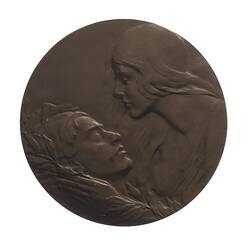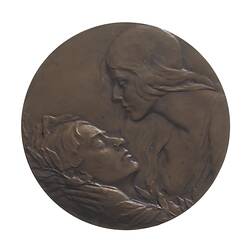Dora Ohlfsen was a multi-talented lesbian sculptor, musician and a writer who lived and worked in Italy, Russia and England. She was one of Australia's foremost medallists and sculptors in the first half of the 20th century. She was born in Ballarat in 1869 (or 1877), daughter of a Russian engineer (or a Pole born in Norway, depending on sources consulted). A promising musician, at the age of 16 she was taken to Berlin to study music under Moritz Moszkowski. She graduated with brilliant results, but developed neuritis in the arm and could not pursue her career as a pianist. Her knowledge of languages meant that she found employment in Moscow as a secretary to the American ambassador, where she translated Russian for him. She also worked as a freelance correspondent for American newspapers.
In 1902, at the age of 33, she entered the French Academy in Rome, where she studied model-making under noted French medallist Pierre Dautel. Italy became her adopted home, and she exhibited her work there and in France. In 1908 the Sydney Morning Herald reported that she had 'a studio and salon in Rome, where she receives visitors from all parts to admire her work - the modelling of portraits in bas-relief. Of this work she is a most successful exponent, and orders crowd upon her. British and American visitors are her chief customers, though she works also for the foreign nobility and the clergy. The medallion in bas-relief of the Prince Bishop of Brizen, Tyrol, is among her finest productions. It has been praised in the French and Italian papers as "the wonderful achievement of a beautiful young Australian, who has only studied art for a comparatively short time".' (June 10 1908)
In 1912 Ohlfsen returned to Australia for exhibitions in Sydney and Melbourne. She began to make Australian portrait plaques and she worked on portraits of celebrated figures in the arts. She returned to Italy in 1914 and became a Red Cross nurse during World War I, which inspired her to make the 1919 ANZAC medal (NU 20766 etc) - at her own expense. She also produced portraits of Australian notables including Billy Hughes and W.A. Holmanin.
On a visit to Australia in 1923 Ohlfsen stated that although she loved Australia there were more opportunities for her artistic skills in Europe. She returned to Italy and portraiture, and in 1925 was commissioned by the Italian Government to produce a war memorial at Formia entitled 'Sacrifice'. In 1926 she portrayed Mussolini, which he received enthusiastically.
In 1948, Ohlfsen and her companion, the Russian Baroness Helene de Kuegelgen, were found gassed in her studio in Rome.
Ohlfsen's work is represented in the collections of the British Museum and the Petit Palais in Paris, and in Australian collections including Museum Victoria and the Art Gallery of New South Wales.
References:
Sheedy, K.A. (1990). 'A New Ohlfsen Medallion in Sydney'. 1990. Numismatic Association of Australia Journal. 5, pp.38-39.
Sheedy, K.A. (1989). 'Dora Ohlfsen, The Forgotten Heroine of Australian Medallic Art', Australian Coin Review. 132, August, Australia, pp.18-21.
Living Room Biographies website http://andrejkoymasky.com/liv/fam/bioo1/ohlf1.html, accessed 19/1/2005.
'Beyond the Pickett Fence' exhibition, National Library of Australia website http://www.nla.gov.au/exhibitions/fence/picket_7.html, accessed 19/1/2005.
More Information
-
Keywords
-
Localities
Ballarat, Victoria, Australia, England, United Kingdom, Italy, Russian Federation
-
Authors
-
Article types





